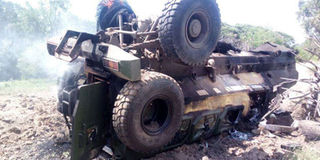Shabaab bombs use explosives seized from Kenyan bases, expert says

Wreckage of an armoured personnel carrier that ran over an improvised explosive device planted by suspected Al-Shabaab militants in Lamu on May 31, 2017. PHOTO | KALUME KAZUNGU | NATION MEDIA GROUP
Material in some of the bombs detonated by Al-Shabaab was seized in raids on Kenyan military bases inside Somalia, according to a researcher who has studied the insurgents' use of improvised explosive devices (IEDs).
In parts of Somalia near the border with Kenya, about 60 per cent of Shabaab's IEDs contain explosives obtained in attacks on Kenyan and other African Union forces or from sub-munitions dropped by Kenyan war planes, said researcher Greg Robin.
Al-Shabaab has reportedly overrun four bases operated by the African Union Mission in Somalia (Amisom). In the process, the militants have made off with large quantities of weapons and “explosive remnants of war.”
PLENTY SUPPLY
Shabaab appears to have a plentiful supply of explosives to sustain its intensified bombing campaign.
“The calendar year 2016 witnessed the highest number of IED events in Somalia ever recorded,” Mr Robin wrote in an email to the Nation. Civilian casualties more than doubled in Somalia last year in comparison to 2015, he noted.
Most of the IED attacks in 2016 took place in Mogadishu. Many explosions also occurred in the Lower Shabelle, Bay, Lower Juba and Gedo regions in southern Somalia.
BOMB MAKERS
Mr Robin carried out an IED threat assessment in Somalia in collaboration with Sahan Research, a think tank with offices in Nairobi, Mogadishu and the UK. His research, conducted on behalf of the British government's Department for International Development, covered the period from December 2015 to March 2017.
Al-Shabaab's IEDs are most commonly produced with military grade RDX-based explosives, Mr Robin said. RDX, also known as cyclonite, was developed in Britain in the 1930s under the heading “Research Department Explosive.” Its blast is more powerful than that of TNT.
Shabaab bomb makers sometimes mix RDX with aluminium powder in order to increase the velocity of the explosion, Mr Robin added.
At earlier stages of the insurgency, such material could be gotten from arsenals in Somalia that dated to the 1969-1991 rule of dictator Siad Barre.
Those sources have now been largely exhausted, Mr Robin noted, leading Shabaab to rely increasingly on other domestically available materials in addition to the explosives seized from Amisom bases.
FINANCIAL SUPPORT
Fertiliser, which can be converted into an explosive substance, is widely available in Somalia because it can be legally imported into the country. Fertiliser use is also promoted by aid organisations active in Somalia for use as part of their agricultural programmes, Mr Robin pointed out.
Shabaab is able to obtain fertiliser in markets or by forcibly expropriating it from farmers.
Components of the radio-controlled firing system for an IED, consisting of mobile phone and car alarm, are available in local markets, especially in Mogadishu, Mr Robin said. Shabaab munitions specialists also typically use a motorcycle 12V battery that can likewise be obtained locally, he added.
Yemen is the only known foreign source of materials for IEDs that take lives in Somalia, Mr Robin said. Detonators and detonating cord are smuggled into the country across the Gulf of Aden.
There is no evidence of Al-Shabaab receiving financial support from any government in the Muslim world, Mr Robin said.





